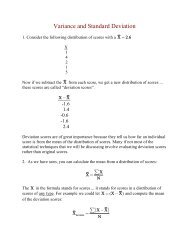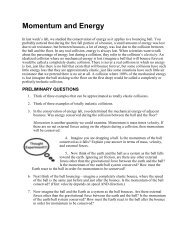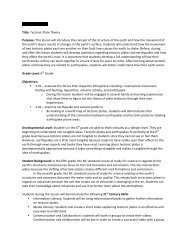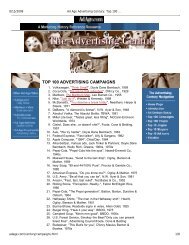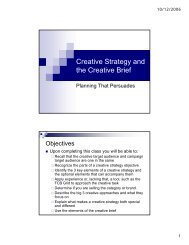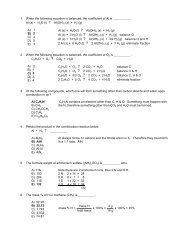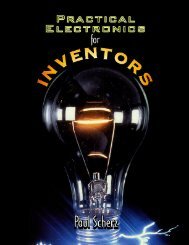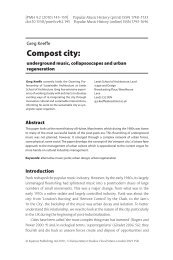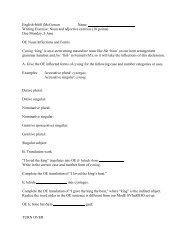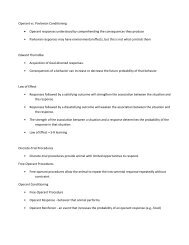Answers to Simulations of the Rescorla-Wagner Model Acquisition ...
Answers to Simulations of the Rescorla-Wagner Model Acquisition ...
Answers to Simulations of the Rescorla-Wagner Model Acquisition ...
Create successful ePaper yourself
Turn your PDF publications into a flip-book with our unique Google optimized e-Paper software.
<strong>Answers</strong> <strong>to</strong> <strong>Simulations</strong> <strong>of</strong> <strong>the</strong> <strong>Rescorla</strong>-<strong>Wagner</strong> <strong>Model</strong><br />
<strong>Acquisition</strong><br />
Simulate five trials <strong>of</strong> acquisition (e.g., ToneFood). Assume that <strong>the</strong><br />
associative strength <strong>of</strong> <strong>the</strong> <strong>to</strong>ne begins at 0 and that k for <strong>the</strong> <strong>to</strong>ne = .4<br />
Trial ΔV<br />
<strong>to</strong>ne<br />
V<br />
<strong>to</strong>ne<br />
1 0.40 .40<br />
2 .24 .64<br />
3 .14 .78<br />
4 .09 .87<br />
5 .05 .92<br />
Extinction<br />
Simulate five trials <strong>of</strong> extinction (e.g., Toneno Food). Assume that <strong>the</strong><br />
associative strength <strong>of</strong> <strong>the</strong> <strong>to</strong>ne begins at 1 and that k for <strong>the</strong> <strong>to</strong>ne = .4<br />
Trial ΔV V <strong>to</strong>ne<br />
<strong>to</strong>ne<br />
1 -0.40 .60<br />
2 -.24 .36<br />
3 -.14 .22<br />
4 -.09 .13<br />
5 -.05 .08
Blocking<br />
Group Exp: Simulate five Phase 1 trials (AUS) followed by five Phase<br />
2 trials <strong>of</strong> blocking (e.g., ABUS). Assume that k A = .3 and k B = .3.<br />
Also assume that <strong>the</strong> associative strength <strong>of</strong> CSs A and B are initially 0.<br />
Keep in mind that <strong>the</strong> associative strength <strong>of</strong> CS A carries over from<br />
Phase 1 <strong>to</strong> Phase 2.<br />
Group Phase 1 Phase 2 Test B<br />
Exp AUS ABUS cr<br />
Con --- ABUS CR<br />
Phase 1<br />
Trial ΔV A V A<br />
1 0.30 .30<br />
2 .21 .51<br />
3 .15 .66<br />
4 .10 .76<br />
5 .07 .83<br />
Phase 2<br />
Trial ΔV A V A ΔV B V B<br />
1 0.05 .88 .05 .05<br />
2 .02 .90 .02 .07<br />
3 .01 .91 .01 .08<br />
4 .00 .91 .00 .08<br />
5 .00 .92 .00 .08
Control Group<br />
Group Control: Simulate five Phase 2 trials (e.g., ABUS). Assume that<br />
kA = .3 and k B = .3. Also assume that <strong>the</strong> associative strength <strong>of</strong> CSs<br />
A and B are initially 0. Keep in mind that <strong>the</strong> control group does not<br />
receive Phase 1 training.<br />
Phase 2<br />
Trial ΔV A V A ΔV B V B<br />
1 0.30 .30 0.30 .30<br />
2 .12 .42 .12 .42<br />
3 .05 .47 .05 .47<br />
4 .02 .49 .02 .49<br />
5 .01 .49 .01 .49<br />
Compare conditioning <strong>to</strong> CS B across <strong>the</strong> experimental and control<br />
groups. Why does CS B condition more in <strong>the</strong> control group relative <strong>to</strong><br />
<strong>the</strong> experimental group? Discuss in terms <strong>of</strong> surprise.
Overshadowing<br />
Simulate five trials <strong>of</strong> overshadowing for both <strong>the</strong> Overshadowing and<br />
Control Groups. Remember that <strong>the</strong> control group receives conditioning<br />
<strong>of</strong> CS B only. Assume that k A = .3 and k B = .1 (i.e., A is more salient<br />
than B). Assume that <strong>the</strong> associative strengths <strong>of</strong> CSs A and B are<br />
initially 0.<br />
Group Training Test Observe<br />
Overshadowing AbUS b cr<br />
Control bUS b CR<br />
Group Experimental<br />
Trial ΔV A V A ΔV B V B<br />
1 0.30 .30 0.10 .10<br />
2 .18 .48 .06 .16<br />
3 .11 .59 .04 .20<br />
4 .06 .65 .02 .22<br />
5 .04 .69 .01 .23
Group Control<br />
Trial ΔV A V A ΔV B V B<br />
1 n/a n/a 0.10 .10<br />
2 n/a n/a .09 .19<br />
3 n/a n/a .08 .27<br />
4 n/a n/a .07 .34<br />
5 n/a n/a .07 .41<br />
Compare conditioning <strong>to</strong> CS B across <strong>the</strong> overshadowing and control<br />
groups. Why does CS B condition more in <strong>the</strong> control group relative <strong>to</strong><br />
<strong>the</strong> overshadowing group? Discuss in terms <strong>of</strong> surprise.
Overexpectation<br />
Simulate five trials <strong>of</strong> overexpectation for <strong>the</strong> experimental group only.<br />
Assume that Phase 1 training (AUS, BUS training is complete). For<br />
this simulation simulate 5 trials <strong>of</strong> Phase 2 (ABUS). Assume that k A =<br />
.2 and k B = .2 and that <strong>the</strong> associative strength <strong>of</strong> both A and B are<br />
equal <strong>to</strong> 1 following Phase 1 (i.e., Va = 1 and Vb = 1).<br />
Group Phase 1 Phase 2 Test Observe<br />
Overexpectation A-->US / B-->US AB-->US b cr<br />
Control A-->US / B-->US no training b CR<br />
Group Overexpectation (Phase 2)<br />
Trial ΔV A V A ΔV B V B<br />
1 -.20 .80 -.20 .80<br />
2 -.12 .68 -.12 .68<br />
3 -.07 .61 -.07 .61<br />
4 -.04 .56 -.04 .56<br />
5 -.03 .54 -.03 .54<br />
How does <strong>the</strong> associative strength <strong>of</strong> CSs A and B change compared <strong>to</strong><br />
<strong>the</strong> control group (<strong>the</strong> associative strength <strong>of</strong> CSs A and B at <strong>the</strong> end <strong>of</strong><br />
Phase 1)? Why does CS B elicit a weaker conditioned response in <strong>the</strong><br />
Overexpectation group relative <strong>to</strong> <strong>the</strong> control group? Discuss in terms <strong>of</strong><br />
surprise.
O<strong>the</strong>r simulations:<br />
Be able <strong>to</strong> simulate and conceptualize <strong>the</strong> US-preexposure effect in<br />
terms <strong>of</strong> <strong>the</strong> <strong>Rescorla</strong>-<strong>Wagner</strong> model. Hint: it is <strong>the</strong> same as blocking<br />
except that <strong>the</strong> context acts as CS A.



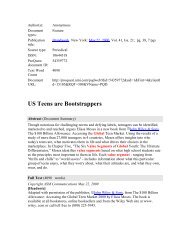

![Graduate Bulletin [PDF] - MFC home page - Appalachian State ...](https://img.yumpu.com/50706615/1/190x245/graduate-bulletin-pdf-mfc-home-page-appalachian-state-.jpg?quality=85)
